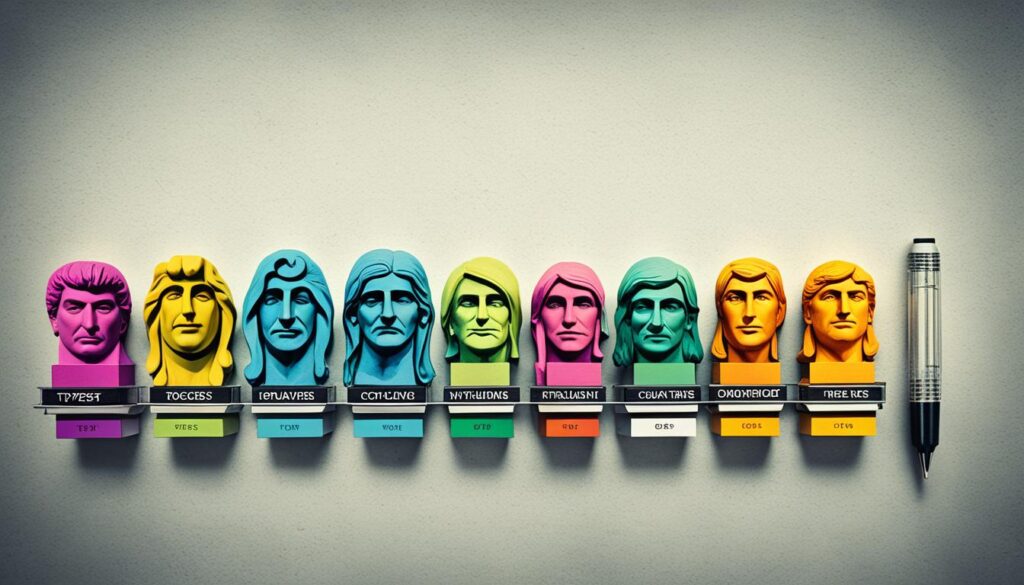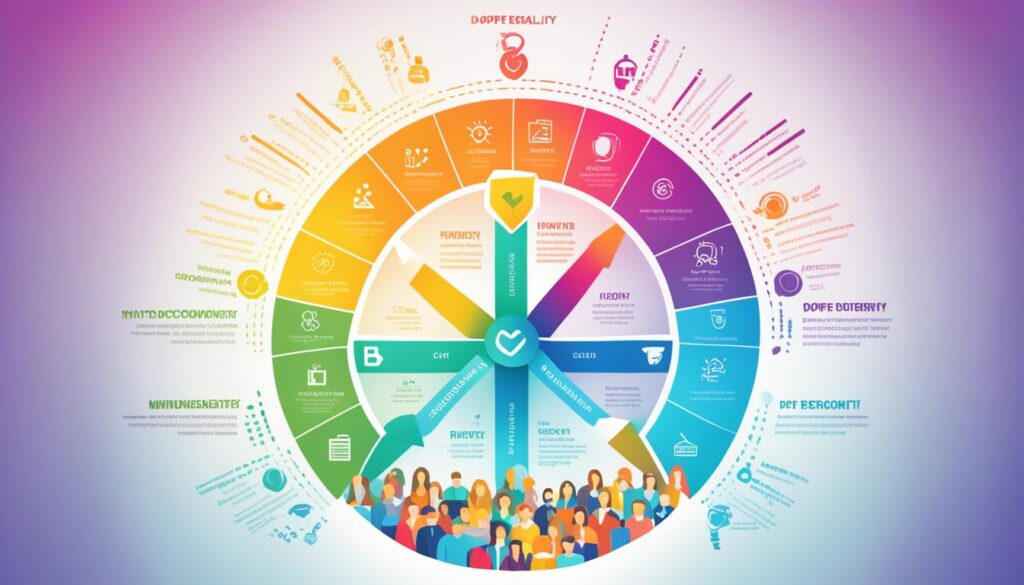Have you heard about the personality test that breaks down complex human behaviors into four distinct bird types? Introducing the DOPE personality test, an entertaining and enlightening method to comprehend various personality traits and preferences. Unlike other tests that rely on numbers or complicated categories, the DOPE test classifies people as Doves, Owls, Peacocks, or Eagles, according to their individual characteristics.
Are you intrigued to learn more about the DOPE personality test and discover what bird type represents your personality? Join us as we dive into the world of the DOPE test and explore the traits and types associated with each bird category.
- The DOPE personality test simplifies personalities into four types represented by birds.
- Doves are friendly and loyal individuals who excel in creating harmony.
- Owls are logical and analytical, thriving in structured environments.
- Peacocks are vibrant and social, bringing innovation and optimism to the table.
- Eagles are confident leaders who thrive on challenges and results.
- Understanding your bird type can enhance self-awareness and improve interpersonal relationships.
The Dove: The Peacemaker
Doves are the friendly and loyal type of individuals. They prefer calm and predictable environments and have an innate desire to be helpful. Doves are great team players and focus on creating harmony and building strong relationships. They excel in roles that require empathy and patience, such as creative fields, human resources, and community engagement.
As peacemakers, Doves bring a sense of calm and stability to their surroundings. They value cooperation and strive to maintain a peaceful and harmonious atmosphere. Their nurturing and supportive nature makes them an asset in team settings, where they excel at mediating conflicts and promoting collaboration.
Characteristics of a Dove:
- Friendliness and loyalty
- Preference for calm and predictable environments
- Desire to be helpful
- Strong focus on creating harmony
- Ability to build strong relationships
- Empathy and patience
With their empathetic nature, Doves excel in roles that require understanding and compassion. They are often drawn to creative fields, where they can use their nurturing qualities to inspire and bring out the best in others. In human resources, Doves shine in fostering positive work environments and resolving conflicts through diplomacy and empathy. Their ability to connect with others on an emotional level also makes them well-suited for community engagement roles, helping to build bridges and create positive change.
When working alongside Doves, it’s important to recognize and appreciate their strengths. They thrive in environments that value collaboration, open communication, and emotional well-being. By leveraging their natural abilities and creating a supportive atmosphere, teams can benefit from the unique contributions of Doves.

Image:
The Owl: The Wise Wizard
Owls are logical and methodical individuals who excel in analytical tasks. With a strong attention to detail, they are often seen as perfectionists. Owls are great at problem-solving and prefer structured environments that allow them to analyze and dissect information. Their ability to think critically and assess situations from multiple angles makes them invaluable assets in various fields.
The Characteristics of an Owl
Owls possess several key characteristics that define their personality type:
- Analytical: Owls have a natural inclination toward analysis and enjoy breaking down complex problems into manageable components.
- Detail-oriented: They have a keen eye for detail and strive for precision in their work.
- Logical: Owls rely on logic and evidence when making decisions and prefer objective reasoning over emotional factors.
- Structured: They thrive in structured environments that provide clear guidelines and well-defined systems.
- Introspective: Owls are introspective individuals who value self-reflection and enjoy exploring complex ideas and concepts.
These characteristics make Owls well-suited for roles that require meticulous attention to detail and a high level of analytical thinking. Occupations such as accounting, software engineering, research, and strategic planning align well with the strengths of Owls.
“The owl can see things that others cannot, and its wise counsel guides us toward insight and understanding.”
A Day in the Life of an Owl
Let’s take a closer look at a typical day in the life of an Owl:
| Time | Activity |
|---|---|
| Morning | Start the day by reviewing the previous day’s work and creating a to-do list, prioritizing tasks based on deadlines and importance. |
| Mid-Morning | Focus on research and analysis, diving deep into data and identifying patterns and trends. |
| Afternoon | Engage in problem-solving activities, collaborating with colleagues to find innovative solutions to complex challenges. |
| Late Afternoon | Take time for reflection and evaluation, reviewing the day’s accomplishments and strategizing for upcoming projects. |
| Evening | Indulge in personal hobbies and activities that stimulate the mind, such as reading, puzzles, or engaging in intellectual conversations. |
By maintaining structure and focus throughout the day, Owls maximize their productivity and ensure that tasks are completed with meticulous attention to detail.

The Peacock: The Cheerleader
Peacocks are vibrant and energetic individuals who thrive in social settings. They have highly developed interpersonal skills and enjoy being the center of attention. Peacocks excel in roles that allow them to bring new ideas to life and drive innovation.
In the workplace, Peacocks are natural cheerleaders who inspire and motivate others. Their enthusiastic and optimistic nature can uplift team spirit and foster a positive work environment. Peacocks are great at building relationships and connecting with people, making them valuable assets in customer-facing roles.

Peacocks are known for their creativity and love for visual aesthetics. They have a knack for design and can add a touch of flair to their work. Whether it’s designing eye-catching marketing campaigns or creating visually appealing presentations, Peacocks have a unique ability to capture attention and make a lasting impression.
With their natural charisma and ability to engage others, Peacocks make excellent communicators. They can effectively convey ideas and persuade others to their point of view. Peacocks thrive in roles such as sales, marketing, and customer success, where their interpersonal skills and ability to connect with others are highly valued.
Peacocks are not afraid to take risks and pursue ambitious goals. They embrace change and enjoy exploring new ideas and possibilities. This adventurous spirit often leads to a fresh perspective and innovative solutions. Peacocks are well-suited for roles in product management, where they can drive innovation and bring new ideas to life.
Characteristics of a Peacock:
- Highly energetic and vibrant
- Strong interpersonal skills
- Enjoys being the center of attention
- Creative and visually-oriented
- Natural charisma and excellent communication skills
- Thrives in social and customer-facing roles
- Comfortable with taking risks and driving innovation
Peacocks play a vital role in organizations by bringing energy, creativity, and a fresh perspective to the table. Their ability to charm and engage others makes them effective communicators and natural leaders. Understanding the characteristics of a Peacock can help individuals appreciate their strengths and leverage them to thrive in their personal and professional lives.
The Eagle: The Leader
Eagles are the epitome of confidence and goal-oriented individuals. They thrive on challenges and have a natural inclination towards leadership roles. With their unwavering determination and fearlessness, Eagles are always striving for results and are not afraid to take risks.
However, the assertiveness of Eagles can sometimes cause them to lose sight of the bigger picture. In their pursuit of success, they may overlook the feelings and perspectives of others. This focus on outcomes and assertiveness can make Eagles appear strong-willed and determined, often leaving a lasting impression.
In the business world, roles that require assertiveness, strategic thinking, and the ability to motivate others are ideal for Eagles. Sales, operations management, business development, and leadership positions are all areas where Eagles can truly shine.
Characteristics of an Eagle:
- Confidence: Eagles exude self-assurance and believe in their abilities to overcome any challenge that comes their way.
- Goal-oriented: Eagles are highly focused on achieving their objectives and are driven by a strong desire to succeed.
- Leadership qualities: With their natural charisma and assertiveness, Eagles possess leadership qualities that inspire and motivate others.
- Risk-takers: Eagles are not afraid to take risks and make bold decisions in order to achieve their goals.
“The best leaders are like Eagles – they soar high, inspire others, and fearlessly navigate through challenges.”
Understanding the characteristics of an Eagle personality type can help individuals harness their strengths and overcome potential weaknesses. By embracing their natural leadership abilities and developing their interpersonal skills, Eagles can become influential leaders who drive success and growth.

Understanding the Bird Types
Each bird type within the DOPE test represents a different personality style and set of traits. Doves are peaceful and friendly, Owls are wise and logical, Peacocks are showy and optimistic, and Eagles are bold and decisive. Understanding these bird types can help individuals and managers better connect and work with others, maximizing productivity and morale in the workplace.

Doves: The Peaceful Peacemakers
In the DOPE test, Doves embody peace, empathy, and a desire for harmonious relationships. They thrive in calm and supportive environments and are known for their compassionate and caring nature. Doves excel in roles that require teamwork, conflict resolution, and emotional intelligence.
Owls: The Wise Wizards
Owls in the DOPE test demonstrate analytical thinking, attention to detail, and logical reasoning. They are highly organized and methodical individuals who excel in problem-solving and data-driven decision-making. Owls feel most fulfilled in roles that require critical thinking, research, strategy development, and complex analysis.
Peacocks: The Showy Optimists
Peacocks are flamboyant, enthusiastic, and creative individuals in the DOPE test. They bring energy, optimism, and a sense of fun wherever they go. Peacocks excel in roles that involve public speaking, creative thinking, marketing, and generating innovative ideas. Their charisma and ability to inspire others make them great team motivators.
Eagles: The Bold Leaders
Eagles are confident, driven, and assertive individuals who emerge as natural leaders in the DOPE test. They are results-oriented and thrive in challenging and competitive environments. Eagles excel in roles that require decisiveness, strategic thinking, and a strong desire to lead and inspire others.
Understanding the bird types in the DOPE test enables individuals to comprehend their own strengths, preferences, and communication styles. It also aids managers in tailoring their leadership approaches to maximize team performance and foster a positive work environment.
Taking the DOPE Personality Test
Are you curious to uncover the secrets of your own personality? Look no further than the DOPE personality test. This quick and insightful tool can provide valuable insights into your unique traits and characteristics. By answering a series of thought-provoking questions, you can determine your dominant bird type and gain a deeper understanding of yourself.
So, how does the test work? It’s simple! Just answer the questions honestly and intuitively. Your responses will help identify your dominant bird type, whether you resonate more with Dove, Owl, Peacock, or Eagle. Each bird type represents different strengths, preferences, and ways of interacting with the world.
The DOPE personality test is an excellent starting point for self-improvement and personal growth. It helps us uncover our dominant bird type and gain insights into our strengths and areas for development.”
By discovering your dominant bird type, you can unlock a wealth of self-awareness and use this knowledge to navigate your interactions with others. Understanding your bird type allows you to leverage your strengths and work on areas that may need improvement, ultimately leading to personal growth and success.
But don’t worry, taking the DOPE test doesn’t mean you’re stuck in a fixed category forever. Our personalities are dynamic, and the test merely serves as a guiding tool. It’s an opportunity to gain a deeper understanding of yourself and embark on a journey of self-discovery.

Discovering your dominant bird type through the DOPE personality test provides a foundation for self-improvement and personal growth. Armed with this knowledge, you can better understand your own behaviors, motivations, and interpersonal dynamics.
| Bird Type | Characteristics | Suitable Roles |
|---|---|---|
| Dove | Peaceful, friendly, empathetic | Counselor, human resources, community engagement |
| Owl | Logical, analytical, detail-oriented | Accountant, software engineer, researcher, strategist |
| Peacock | Vibrant, energetic, optimistic | Marketer, salesperson, customer success, product manager |
| Eagle | Confident, assertive, goal-oriented | Sales, operations management, business development, leadership |
History of the DOPE Personality Test
The DOPE personality test is rooted in the original four personality types developed by Dr. Gary Couture, a renowned expert in the field of personal development. Dr. Couture’s groundbreaking work laid the foundation for the creation of the DOPE test, which has since evolved and gained significant recognition.
Throughout its history, the DOPE test has incorporated insights from various personality tests and research studies, enhancing its accuracy and effectiveness. By embracing these valuable perspectives, the test has become a comprehensive tool for understanding individual traits and behaviors.
Development and Refinement
Over time, the DOPE test has undergone refinements through the meticulous analysis of thousands of test results and the contributions of experts in the field. These refinements have further enhanced the test’s ability to provide individuals with accurate and insightful feedback on their personality traits and preferences.
“The DOPE test has become a widely used and trusted tool in personal development, thanks to its rich history and continuous refinement.” – Dr. Jane Peterson, Psychologist
Researchers and practitioners have continuously expanded the test’s knowledge base by drawing from the latest psychological studies and theories. By remaining informed of the latest research, the DOPE test ensures that individuals receive the most up-to-date and relevant insights into their personalities.

Unlocking Personal Potential
The history of the DOPE test demonstrates its commitment to empowering individuals to reach their full potential. By recognizing and understanding the origins of the test, individuals can appreciate the depth of research and expertise that has gone into its development.
With its solid foundation and ongoing refinement, the DOPE test continues to provide individuals with valuable insights into their personalities. By leveraging this knowledge, individuals can enhance their self-awareness, improve their relationships, and maximize their personal growth.
| Key Milestones | Significance |
|---|---|
| Development of the original four personality types | Provided the basis for the creation of the DOPE test |
| Incorporation of insights from other personality tests and research studies | Enhanced the accuracy and effectiveness of the DOPE test |
| Refinements based on the analysis of thousands of test results | Ensured the test’s validity and reliability |
| Integration of the latest psychological research and theories | Kept the DOPE test up-to-date and relevant |
Benefits of the DOPE Personality Test
The DOPE test offers individuals a range of benefits, helping them gain a deeper understanding of their personality and how it can impact their lives. By recognizing their dominant bird type, individuals can leverage this knowledge to enhance their personal and professional growth.
Enhanced Self-Awareness
The DOPE test provides individuals with valuable insights into their strengths, weaknesses, and natural inclinations. By understanding their dominant bird type, individuals gain a clearer understanding of their preferences, behaviors, and reactions in various situations.
This increased self-awareness allows individuals to make more informed decisions about their career choices, personal goals, and interpersonal relationships. It empowers them to play to their strengths and overcome challenges, leading to greater personal fulfillment and success.
Improved Communication
One of the most significant benefits of the DOPE test is its ability to enhance communication skills. By understanding their dominant bird type and the communication style associated with it, individuals can adapt their approach to better connect and engage with others.
“The DOPE test helped me understand my communication style as an Eagle. I realized that my direct and assertive approach could sometimes come across as intimidating. Armed with this knowledge, I’ve been able to adjust my communication style to be more inclusive and approachable, leading to better collaborations and stronger relationships.” – Jane Smith, Marketing Manager
By recognizing and respecting the communication preferences of others, individuals can foster more effective and harmonious interactions, whether in personal relationships or professional settings.
Improved Interpersonal Relationships
The DOPE test can significantly impact how individuals perceive and engage with others. By understanding the different bird types and the unique characteristics associated with each, individuals can develop a greater appreciation for diversity and a deeper empathy for others.
When individuals recognize and respect the differences in personality styles, they can build stronger relationships and navigate potential conflicts more effectively. This understanding fosters a more inclusive and supportive environment, leading to improved cooperation, teamwork, and overall well-being.
Alignment of Actions and Goals
By identifying their dominant bird type, individuals can align their actions and goals with their natural tendencies and inclinations. This self-awareness enables individuals to make choices that leverage their strengths and maximize their potential for success.
For example, an individual with a dominant Dove personality type, characterized by a desire for peace and harmony, may seek out roles that involve mediation or conflict resolution. On the other hand, someone with a dominant Eagle type, known for their boldness and leadership qualities, may be more inclined to pursue positions in management or entrepreneurship.
Understanding one’s dominant bird type can guide individuals in making career decisions, setting personal goals, and designing a life that is authentic and fulfilling.

| Benefits of the DOPE Personality Test |
|---|
| Enhanced self-awareness |
| Improved communication |
| Improved interpersonal relationships |
| Alignment of actions and goals |
Applying the DOPE Personality Test in the Workplace
As managers, we can leverage the insights gained from the DOPE personality test to better understand our team members’ unique personalities and tailor our management approach accordingly. By recognizing each individual’s dominant bird type, we can create a work environment that fosters collaboration, supports individual growth, and maximizes team performance.
Understanding the different bird types represented in the DOPE test – Dove, Owl, Peacock, and Eagle – can provide us with valuable information about our team members’ strengths, communication styles, and work preferences. Armed with this knowledge, we can effectively assign tasks, build diverse teams, and create opportunities for personal and professional development.
One way to apply the DOPE personality test in the workplace is by assigning roles and responsibilities that align with each bird type’s characteristics. For example, Doves, known for their friendly and empathetic nature, may excel in customer service or positions that require a high level of teamwork. On the other hand, Owls, with their logical and analytical thinking, are well-suited for tasks that require attention to detail and problem-solving abilities.
Additionally, understanding the different bird types can help us navigate conflicts and improve team dynamics. By recognizing the innate tendencies and communication styles of each bird type, we can foster open dialogue, encourage empathy, and mediate conflicts more effectively. This knowledge allows us to create an inclusive and harmonious work environment where every team member feels valued and understood.
Table: Applying the DOPE Personality Test in the Workplace
| Bird Type | Characteristics | Suitable Roles |
|---|---|---|
| Dove | Friendly, empathetic, team-oriented | Customer service, teamwork-focused roles |
| Owl | Logical, detail-oriented, analytical | Problem-solving, research, analytical roles |
| Peacock | Outgoing, creative, optimistic | Marketing, sales, creative roles |
| Eagle | Confident, assertive, goal-oriented | Leadership, sales, project management roles |
By using the DOPE personality test as a tool for understanding and managing different personality types, we can foster a supportive and productive work environment. Embracing the unique strengths and preferences of each team member promotes individual growth, boosts team collaboration, and ultimately leads to enhanced overall performance.
Remember, the DOPE test is not about labeling individuals or putting them in boxes. It’s about understanding and appreciating the unique qualities each person brings to the team.
The DOPE Test as a Tool for Personal Growth
The DOPE test is not only a fascinating way to understand different personality types but also a powerful tool for personal growth and self-improvement. By delving into the depths of the DOPE test and understanding their dominant bird type, individuals can gain valuable insights into their own strengths, weaknesses, and areas for development.
Each bird type within the DOPE test represents a distinct set of characteristics and qualities. For example, Doves are known for their peaceful and friendly nature, while Owls bring wisdom and logical thinking to the table. Peacocks are all about bringing vibrant energy and creativity, and Eagles are natural-born leaders who thrive on challenges.
Knowing your bird type empowers you to focus on enhancing your strengths and working on the areas that need improvement. It provides a framework for self-reflection and guides you in your personal and professional journeys. Whether you want to strengthen your relationships, improve your communication skills, or enhance your decision-making abilities, the DOPE test can serve as a roadmap for personal growth.
By using the insights from the DOPE test, you can tailor your approach to different situations, adapt your communication style to connect better with others, and build harmonious relationships both in your personal and professional life.
Using the DOPE Test for Self-Improvement
Once you understand your dominant bird type, you can begin to explore ways to leverage your strengths and overcome your weaknesses. Here are a few strategies to help you use the DOPE test for self-improvement:
- Embrace your strengths: Identify your dominant bird’s unique qualities and find opportunities to apply them in your daily life. Whether it’s using your empathy and listening skills as a Dove or your analytical thinking as an Owl, embracing your strengths allows you to shine and achieve greater success.
- Challenge yourself: Step out of your comfort zone and take on tasks or roles that push you to grow. If you’re an Eagle, for example, seek out leadership opportunities that allow you to showcase your natural assertiveness and decision-making abilities.
- Develop new skills: Recognize the areas where you could benefit from improvement and actively work on developing new skills. If you’re a Peacock, for instance, focus on honing your organizational skills or learning to balance high energy with focused productivity.
- Seek feedback: Regularly seek feedback from trusted individuals to gain different perspectives on your strengths and areas for improvement. This feedback can provide valuable insights and help you refine your self-improvement efforts.
- Continuously learn and grow: Personal growth is an ongoing process. Stay curious, seek out new knowledge, and invest in personal development activities that align with your bird type. This could include reading self-help books, attending workshops, or even finding a mentor who can guide you on your journey of self-improvement.
Remember, the DOPE test serves as a starting point for self-improvement. It provides you with a better understanding of your personality and guides you toward maximizing your potential. By using the insights from the DOPE test and actively working on your personal growth, you can unlock new opportunities, build fulfilling relationships, and live a more authentic and purposeful life.

Conclusion
The DOPE personality test offers a unique and simplified approach to understanding different personality types. By identifying your dominant bird type, you can gain valuable insights into your own preferences and traits. This knowledge allows you to navigate your personal and professional relationships with greater understanding and empathy.
One key takeaway from the DOPE test is the importance of recognizing and appreciating the diversity of personality types. Each bird type brings its own strengths and perspectives to the table, and by embracing these differences, we can foster a more inclusive and collaborative work environment.
Furthermore, the DOPE test highlights the significance of effective communication. Understanding your bird type can help you tailor your communication style to better connect with others and avoid potential misunderstandings. This can lead to improved teamwork, enhanced productivity, and reduced conflicts.
In conclusion, the DOPE personality test provides valuable insights into individual preferences and behaviors. By leveraging this understanding, we can build stronger relationships, foster effective communication, and create a more harmonious and productive work environment.
FAQ
What is the DOPE Personality Test?
The DOPE Personality Test is a unique and fun way to understand different personality types. It simplifies personalities into four types represented by birds: Dove, Owl, Peacock, and Eagle.
What are the characteristics of a Dove?
Doves are friendly and loyal individuals who excel in creating harmony and building strong relationships. They prefer calm and predictable environments and are great team players.
What are the characteristics of an Owl?
Owls are logical and methodical individuals who excel in analytical tasks. They have a strong attention to detail and are great problem solvers.
What are the characteristics of a Peacock?
Peacocks are vibrant and energetic individuals who thrive in social settings. They have highly developed interpersonal skills and enjoy being the center of attention.
What are the characteristics of an Eagle?
Eagles are confident and goal-oriented individuals who enjoy taking on challenges. They are natural leaders who strive for results and are not afraid to take risks.
What does each bird represent in the DOPE test?
Doves represent friendly and loyal individuals, Owls represent logical and methodical individuals, Peacocks represent vibrant and energetic individuals, and Eagles represent confident and goal-oriented individuals.
How do I take the DOPE Personality Test?
By answering a series of questions, you can determine your dominant bird type and gain a deeper understanding of your strengths and potential areas for growth.
What is the history of the DOPE Personality Test?
The DOPE test is based on the original four personality types developed by Dr. Gary Couture. It has evolved over time and incorporates insights from other personality tests and research studies.
What are the benefits of the DOPE Personality Test?
The DOPE test provides individuals with a better understanding of their personality, improves communication, enhances self-awareness, and helps improve interpersonal relationships.
How can the DOPE Test be applied in the workplace?
Managers can use the insights from the DOPE test to understand their team members’ personalities and tailor their management approach accordingly. It helps create a work environment that promotes collaboration and individual growth.
How can the DOPE Personality Test help with personal growth?
By understanding your dominant bird type, you can identify areas for development and focus on enhancing your strengths. The test provides a framework for self-reflection and guides you in your personal and professional journeys.
Eugene brings a fresh, dynamic voice to our platform as one of our talented Writers. Specializing in research-driven content, he explores the latest findings in psychology and personal growth, translating them into actionable insights for our readers. Eugene’s work is fueled by a curiosity about what makes us tick and a desire to help others unlock their potential.










